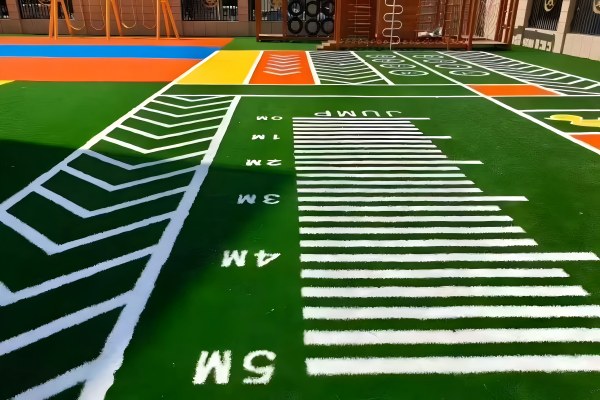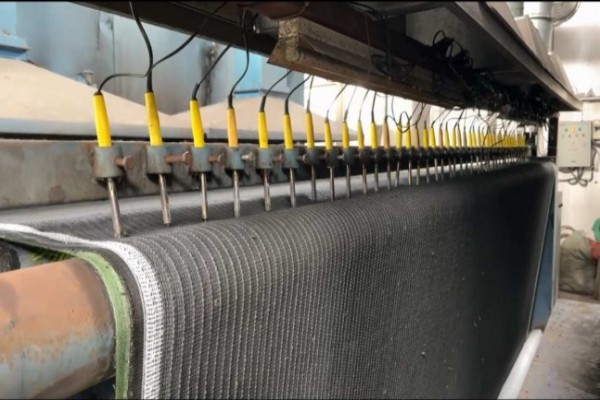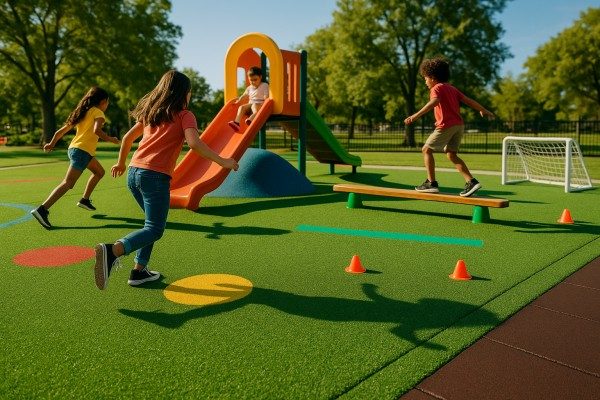Worried about kids getting hurt on rough playgrounds? Traditional surfaces wear out fast and cause muddy messes. Artificial grass offers a safe, clean, and durable solution for worry-free play.
Artificial grass is the ideal choice for school playgrounds because it provides a safe, cushioned surface that minimizes injuries from falls. Its high durability withstands heavy use, requires minimal maintenance, and ensures a clean, mud-free play area year-round, making it a cost-effective and reliable solution.

I’ve seen countless schools struggle with their playgrounds over my 15 years in this industry. They pour money and time into maintaining natural grass, only to see it turn into a muddy pit after a single rainstorm. They worry constantly about kids tripping in holes or getting scraped on hard, worn-out patches. There has to be a better way to create a space that is fun, safe, and doesn’t become a maintenance nightmare. Let’s look at why so many are now choosing high-quality artificial turf for their schools.
Is artificial grass good for a play area?
Is your play area a muddy mess after it rains? Kids track dirt everywhere, and the ground is uneven and unsafe. Artificial grass stays perfect in any weather.
Yes, artificial grass is excellent for a play area. It provides a consistently even and soft surface, which is much safer than hard dirt or patchy grass. It drains water quickly, eliminating mud and puddles, so kids can play almost immediately after rain.

When I talk to clients, especially business owners like Mohammed who are responsible for large projects, their main concern is performance. They need a product that works every single day. Artificial grass delivers on this promise for play areas. It solves some of the biggest problems that come with natural grass.
All-Weather Playability1
Natural grass fields become unusable after heavy rain. They turn into mud, which means recess gets cancelled and kids are stuck indoors. Artificial grass has a superior drainage system. The backing of the turf has perforation holes, and it’s installed over a base of crushed stone. This allows water to drain right through. I’ve seen fields ready for play just an hour after a downpour. This means more playtime for kids and less disruption for the school.
Consistent and Even Surface2
I once worked with a school that had to replace its natural grass field because two students sprained their ankles in the same month. The ground was full of hidden lumps and holes. This is a common and serious risk. Artificial grass provides a completely flat and uniform surface. There are no surprise dips or holes to trip over. This consistency is crucial for creating a truly safe environment where children can run and play freely without you having to worry.
Low Maintenance, High Usage3
Schools operate on tight budgets. The cost of mowing, watering, fertilizing, and weeding a natural grass field adds up quickly. Artificial turf requires very little maintenance—just occasional brushing to keep the fibers upright and rinsing to clear away debris. This saves a huge amount of money and staff time over the turf’s long lifespan. More importantly, it can handle heavy, constant use without wearing out.
Is synthetic grass safe for kids?
Every parent’s worst fear is a playground injury. Hard surfaces like asphalt or compacted dirt offer no protection from falls. Synthetic grass provides a crucial safety layer to protect children.
Absolutely. Modern synthetic grass is specifically designed for safety. It’s made from non-toxic, lead-free materials. When installed with a proper shock-absorbing underlay, it meets critical fall height standards, significantly reducing the risk of injury from falls.

Safety is not negotiable, especially when children are involved. I always stress this with my customers. When you are bidding for a school project, being able to guarantee safety is your biggest advantage. High-quality synthetic grass is one of the safest surfaces available for playgrounds, and here’s why.
Material Safety and Certifications
A common question I get is, "What is it made of?" People worry about harmful chemicals. I tell them that reputable manufacturers, like us at QH Grass, only use new, non-toxic materials. Our products are tested and certified to be free of lead and other heavy metals. I always advise clients to ask for these lab reports and certifications, like SGS or CE. This is how you build trust and prove you are providing a safe product for children.
Fall Protection and Cushioning
Falls are going to happen on a playground. The key is to make the landing as soft as possible. This is where a shock pad, installed underneath the turf, is essential. This foam underlay acts as a cushion. The thicker the pad, the more impact it can absorb. We measure this with a "Critical Fall Height4" (CFH) rating. This tells you the height from which a child can fall without sustaining a life-threatening head injury. A proper installation can meet safety standards for even the tallest playground equipment.
Reducing Allergies and Pests
Many children suffer from grass pollen allergies. Natural grass can make playtime miserable for them. Since artificial turf is made from synthetic fibers, it’s hypoallergenic5. It completely removes that source of allergens from the environment. Additionally, it doesn’t provide a home for pests like ants, ticks, or other biting insects. This creates a much cleaner and healthier space for everyone.
What are the advantages and disadvantages of artificial grass?
Thinking about artificial grass but unsure if it’s the right choice? It is a big investment, and you need to know the full picture. Let’s weigh the pros and cons honestly.
The main advantages are low maintenance, durability, excellent safety features, and all-weather usability. The primary disadvantages are the higher initial installation cost compared to natural grass and the potential for the surface to get hot in direct sunlight.

For any major purchase, a clear cost-benefit analysis is necessary. I always make sure my clients understand both sides of the coin before they make a decision. A good business relationship is built on trust and transparency. Here is a straightforward breakdown of what you can expect from an investment in artificial grass for a playground.
| Advantages | Disadvantages |
|---|---|
| Low Maintenance6 (No mowing, watering) | Higher Initial Cost7 (Upfront investment) |
| High Durability (Withstands heavy use) | Heat Retention8 (Can get hot in the sun) |
| Excellent Safety (Cushioning & non-toxic) | Requires Professional Installation |
| Always Green & Clean (No mud or bare spots) | Not Biodegradable |
| Water Conservation (Saves on water bills) | |
| Allergen-Free |
Advantages Explained
The long-term savings are significant. While the initial price is higher, the return on investment is clear. Over the 10-15 year lifespan of the turf, a school will save thousands on water bills, lawnmowers, fuel, and labor costs. Its durability means it won’t get bare patches in high-traffic areas like under swings or at the bottom of slides. It looks great year-round, which improves the overall appearance of the school.
Disadvantages and Solutions
I am always direct about the challenges. The upfront cost is the biggest hurdle for most clients. However, when you spread that cost over its lifespan, it’s often cheaper than maintaining natural grass. For heat, which is a major concern for my clients in places like Saudi Arabia, there are good solutions. We can use special infill materials that stay cooler than black crumb rubber. We also have turf products with heat-reflective technology in the fibers. And on the hottest days, a quick spray with a hose can cool the surface down in minutes.
Conclusion
In short, artificial grass provides a safe, durable, and low-maintenance playground solution. It gives children a clean and consistent surface for year-round play, making it a smart long-term investment.
-
Explore how all-weather playability enhances outdoor activities, ensuring kids can play anytime without interruptions. ↩
-
Learn why a flat surface is crucial for safety in play areas, preventing injuries and ensuring a fun experience for children. ↩
-
Discover how low maintenance artificial grass can save time and money while providing a durable solution for high-traffic areas. ↩
-
Learn about Critical Fall Height and its importance in preventing playground injuries. ↩
-
Discover how hypoallergenic synthetic grass can improve playtime for children with allergies. ↩
-
Explore how low maintenance artificial grass can save you time and money while keeping your space beautiful. ↩
-
Understanding the reasons behind the higher initial cost can help you make an informed decision about your investment. ↩
-
Discover effective solutions to manage heat retention in artificial grass, making it more comfortable for use in hot climates. ↩
_画板-1.png)
_画板-1.png)